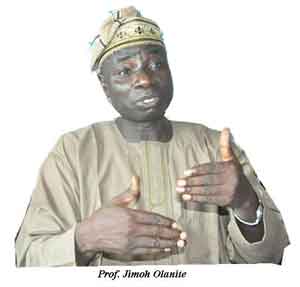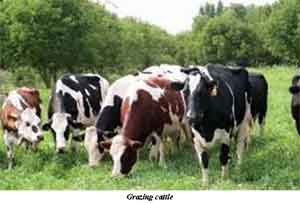A Professor of Pasture Agronomy and Forage Utilisation, College of Animal Science and Livestock Production (COLANIM), Federal University of Agriculture, Abeokuta (FUNAAB), Professor Jimoh Olanite, has identified the opportunities that abound in the production of hay from sown pasture for ruminant animal production, as he called on Fulani herdsmen, the University Management and Government in general, to tap into it.
According to him, the availability of steady supply of herbaceous forage legumes and grasses, as feed resources for ruminant animal production, had been of great challenge for livestock farmers in the country, leading to the damage of farmlands. Professor Olanite, whose research interest involves the evaluation of grasses and herbaceous legumes as feed resources for ruminant animal production, disclosed that species like Panicum maximum and Brachiaria decumbens were common grasses that could withstand grazing pressure and are highly nutritious.


The University Don disclosed that the major outcomes of his research on sown pasture revealed that the Fulani herdsmen were ready to utilise technologies, if the right environment was provided. Disclosing how he recorded this feat, Professor Olanite said, “when we started our study at Oja-Odan in the Yewa North Local Government Area of Ogun State, we brought the herdsmen to site, to see what we were doing and they saw that if pasture was grown and managed well, it will provide feed for their animals year-round and the quality will be a lot better than what is currently available to them from the natural pasture. What the herdsmen are used to is grazing the natural pasture but this cannot be controlled unlike a pasture that is planted and managed using the right fertilizer, which gives better quality feed. This made the herdsmen to agree with us that if adopted, the use of planted pasture could enhance the productivity of their animals. A follow-up survey, which was a component of the study by colleagues in the Departments of Agricultural Extension and Rural Development, as well as Agricultural Economics and Farm Management (College of Agricultural Management and Rural Development), also indicated interest of the herdsmen in the adoption of sown pasture technology for enhanced animal productivity”.
Professor Olanite noted that he and his other colleagues were currently working on another research proposal aimed at extending this technology to solve problems relating to animal grazing in the South-West Nigeria, saying “The problem of herdsmen destroying the environment is becoming rampant in this area because the land holding situation in the South-West is not like the Northern part of the country”. He noted further that the government was now talking about the establishment of grazing reserves all over the country and wondered how many states in the South-West Nigeria could donate lands running into hundreds of hectares for such projects? “This will be difficult because lands are already highly fragmented, families own their own land and do their farming on them. How will you tell a family to leave its own land for you to turn to grazing reserve? This may not bring about peaceful coexistence and harmony within the communities. Herdsmen that want to do their animal rearing business here are likely to establish cattle fattening projects, whereby their animals will not be allowed to move around. This is probably the best system of production for South-West, Nigeria. The herdsmen actually need to acquire some skills in pasture production, management and utilisation. Our interest now, as a Department, is looking for ways of enhancing the capacity of the herdsmen themselves for the production and utilisation of sown pasture for animal production”, he stated.
The Professor of Pasture Agronomy and Forage Utilisation, who noted that the University could take advantage of the missing gap by engaging in sown pasture for sale to livestock farmers, pointed out that when sold as fresh feed, the digestibility of forages was higher, while the ability of the animal to extract nutrients from the plants was also higher. According to him, forages are also not useless when dry, but their quality and utilisation by animals will depend on the stage of their growth when they were cut for preservation, noting that “If they are cut when they are fully grown and have produced a lot of stems, what will be available will just be trash that animals will not benefit much from, but if cut at the right growth stage, their nutrient content is high and this is also preserved along with dry matter. All that will be required is just to find a way to reduce the moisture level, so that it will not grow mouldy when stored. Reducing the moisture level does not mean that the protein and other nutrients are still in the dry matter”.
“The stems that are cut along with the forage, when they are fully mature, do not contain the nutrients and even if the nutrients are available in them, animals cannot digest the stem to utilise the nutrients. Even though, the nutrient level in the preserved forage may not be as high as when it was fresh, it will supply the animals with maintenance ration, pending when fresh feed will become available. The University has the capacity to establish pasture, produce hay and silage on commercial scale, given the human resources in the Department of Pasture and Range Management (COLANIM) and the extensive FUNAAB land. By so doing, the University can become a model for entrepreneurs, who are interested in investing in cattle production ventures.”
“When we talk about pasture, especially sown pasture, we do not talk about grasses alone, but we also talk about the legume component as well. In this part of the country, Stylosanthes species are generally acceptable and after planting, they cover the ground in good time and they are very resilient to grazing effects. Some species of Stylosanthes that have been extensively evaluated and used in on-station and on-farm adaptive grazing studies generally in Nigeria and in the South-West, in particular, are: Stylosanthes guainensis and Stylosanthes hamata. These legumes can be used for the establishment of extensive pasture lands and for improvement of the natural grazing land. Pasture establishment and management is capital-intensive and may take a large chunk of capital investment in a cattle production venture. Adequate post-establishment routine management, such fertilizer application, rouging or spot weeding, re-seeding, as well proper grazing management, are also required to ensure long-term productivity of established pastures”, he said.
Professor Olanite disclosed that the high cost of pasture establishment may discourage the potential investors from modern cattle production ventures especially when “the natural pasture provides an alternative feed resource at no cost”. Sharing his views on research activities in the country, Professor Olanite said research should be targeted at proffering solutions to the nation’s problems, saying Nigeria was still faced with many developmental issues, indicating that there was still the need for more cutting-edge researches from our universities and research institutes. He called on the government to invest more in research and provide the right environment for researches to thrive without which it may be difficult for the country to achieve its desired growth. He also urged the government to put square pegs in square holes, so as to achieve the desired change that the country needed. “We need to have the right people in the right place and the government must also have the political-will to make things work. For example, let the government challenge the various universities and research institutes to research into identified key developmental issues and back them up with adequate funding and let us see whether these institutions will not perform beyond expectation”, the Don stated.
